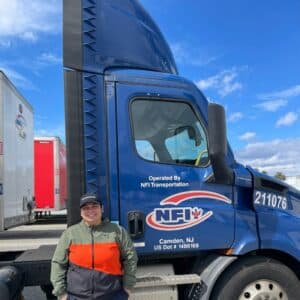NFI’s Driver Finishing Program fosters diverse, tech-savvy new generation of truckers
 The federal government has implemented a number of initiatives to speed the movement of goods across the country. To combat an estimated shortage of approximately 80,000 drivers, the Biden administration’s Trucking Action Plan includes an expanded apprenticeship program designed to attract and retain talent. Maria Rodriguez, a 34-year-old mother and first-generation Venezuelan immigrant, is a trainee in the program. We met Maria in April, soon after she had been nominated by NFI– her employer and apprenticeship sponsor– to participate in a special event.
The federal government has implemented a number of initiatives to speed the movement of goods across the country. To combat an estimated shortage of approximately 80,000 drivers, the Biden administration’s Trucking Action Plan includes an expanded apprenticeship program designed to attract and retain talent. Maria Rodriguez, a 34-year-old mother and first-generation Venezuelan immigrant, is a trainee in the program. We met Maria in April, soon after she had been nominated by NFI– her employer and apprenticeship sponsor– to participate in a special event.
Maria was chosen to give a brief address and introduce the President of the United States on the White House lawn. You might imagine that anyone surrounded by celebrities and high-level officials would be intimidated, but Maria saw this as an advocacy opportunity. “Since I did that White House event,” she says, “I want to inspire other females and Latinas—or other minorities—to get into this business. If I could do it, anyone can do it.”
An Unexpected Shift
Maria has been in trucking for less than a year. She’d been one of the many longtime restaurant workers laid off because of COVID. “I needed to find a career where I will always have a job, no matter what happens,” she said. “I knew I needed to be an essential worker.”
Then, following her boyfriend’s encouragement, she joined him at a nearby truck driving school. “I ended up falling in love with it, like he did,” she says. She appreciates the universal need for drivers. “Anything, anything you buy comes from a truck driver. That’s what we were looking for: stability.” She graduated from driving school and joined NFI as a driver trainee. She’s been pleased with the company’s “earn-while-you-learn” model; it helps drivers hone their safety skills, has them home every day, and provides benefits from day one.
“There’s Just An Equal Job”
When asked about her experiences as a woman in a male-dominated profession, she replies, “I’m the only woman at my job right now.” Before joining NFI, she had some encounters she felt were discriminatory. “I had to tell a few of them to relax.
“Even my mother, she didn’t want me to do trucking. And a friend of a friend said, ‘Oh, that’s a trabajo paro los hombres.’ But, you know, it isn’t. There isn’t ‘a man’s job’ and there isn’t ‘a woman’s job.’ There’s just an equal job.”
Prejudices about women and minorities in trucking are being addressed on a broader scale. Diversity awareness is rising. Recruitment efforts from government entities, private companies, and industry organizations have invested in messaging that encourages job seekers from all backgrounds to consider getting behind the wheel.
Freight carriers have struggled tremendously with driver retention. Articles often cite a staggering “90% turnover” for many carriers, but these drivers aren’t necessarily leaving the industry. According to the American Trucking Associations, they’re hopping between companies. Fortunately, Maria is part of an apprentice program that fits her needs and lifestyle very well.
The “Real World” Day-To-Day
When asked about the downsides of her job, Maria replies that, after having finished CDL school and an eight-week training program, “The real world is so different.” She is hooking tractors to trailers in the rain and cold. She is waking up so early that the friends she phones for company haven’t even gone to bed yet. She is no longer maneuvering through practice cones, but through illegally-parked cars and dumpsters on narrow New England streets. But she finds overcoming those challenges “very rewarding.”
“I drive overnight,” says Maria. “My family is asleep and I come home before they wake up. I sleep when my son’s in school. My load is to be picked up at midnight and I’m usually home by 8 a.m.”
As far as improvements she’d like to see in the industry, Maria mainly wants one thing. “I think there needs to be more female trainers. There’s barely any female trainers. One of my CDL trainers was rude, but I have a thick skin. For those that don’t, it could have scared them away. If there were more women in the industry—or mentorship programs—more females would start their career.”
Overall, Maria enjoys her new line of work. “I really love it when older women see me in the driving seat and do a double take.” She mimics their surprised “Oh!” and laughs. “And then they wave and give me a thumbs-up. They’re just like, ‘Wow, there’s a female driving.’ I think that’s pretty inspiring.
“And also, I really just love being able to supply. It’s very rewarding, at the end of the day, when you say ‘Well, I just drove to New York City and back with this big 48-foot trailer, and I supplied.” She pronounces “supplied” almost reverently, as if it had a capital “s.” She continues, “We work a major office retail account and fill stores with their necessities. So, it’s rewarding in that sense. I think that just being able to supply—and also inspiring people—is my motivation.”
How Many More Marias Will Train?
Maria found her way into this line of work mostly by chance. She and her boyfriend noticed a stream of student truck drivers passing their apartment and found that the school was “only two minutes away.” Thousands upon thousands of drivers are still needed, and few people have the good fortune to see obvious “consider this career” indicators through their front window. She is part of an industry shift that will hopefully make driving careers more comfortable and satisfying for the latest generation, and attract much-needed workers.
Recruitment initiatives have been targeted at populations that are not traditionally top-of-mind among trucker demographics. Women, BIPOC, and the previously-incarcerated are all being courted as potential applicant pools, in addition to the well-represented “military veteran” contingent.
A Tech-Savvy Generation in the Fleet
As Millennial and Gen-Z drivers join fleets, technology may be a significant factor in keeping them on board. At an industry level, up-to-date software like Transfix FMS are designed to mitigate some day-to-day annoyances by decreasing detention times, offering backhaul opportunities, and ultimately helping drivers keep their trucks loaded.
At a more personal level, smartphone features and apps make a driver’s life easier. Social media and messaging platforms can address loneliness issues. Review websites and navigation apps might make it easier to find lodging, better restaurants, and secret shortcuts around traffic jams. The catch is that these resources are only available to those who are comfortable using them: “tech hesitance” prevents some segments of drivers from adopting such solutions, possibly due to generational or subcultural preferences. But not Maria! She makes use of all the tech tools common to her age group, including sharing her enthusiasm for her new trade on social media.
Maria is only one voice, but that voice doesn’t falter or vacillate . . . not even when introducing the President of the United States. She plans to encourage more people from diverse backgrounds to pursue opportunities in supply chain careers.
Ten years from now, will people still react with surprise when they see a Latina woman operating a five-ton truck? Not if Maria Rodriguez has anything to say about it.




